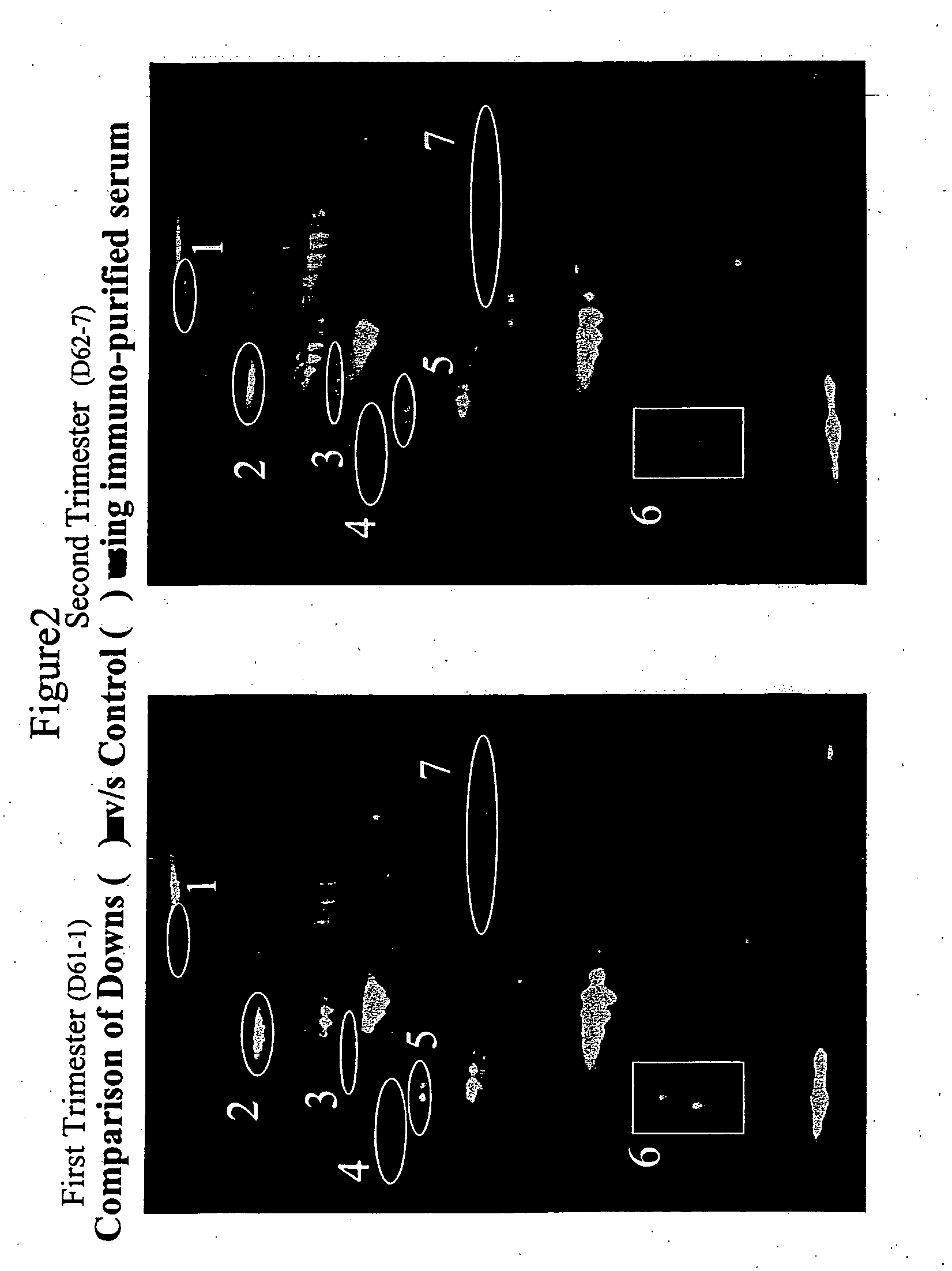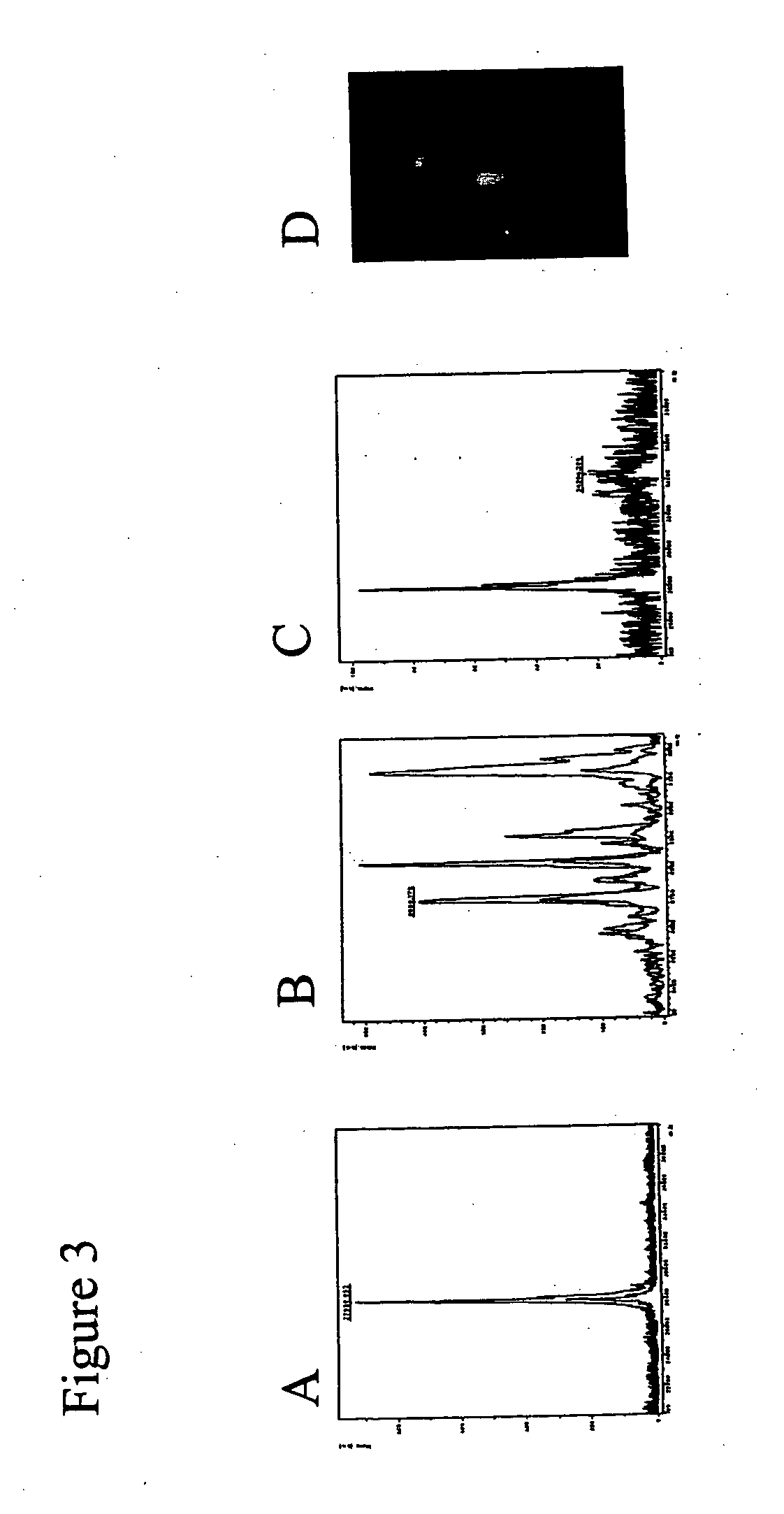Diagnosis of fetal aneuploidy
a fetal aneuploidy and non-invasive diagnosis technology, applied in the field of early non-invasive diagnosis of fetal aneuploidy, can solve the problems of large percentage of affected individuals failing to reach adulthood, unable to provide information on the regulation of protein function through post-translational modifications, proteolysis or compartmentalization,
- Summary
- Abstract
- Description
- Claims
- Application Information
AI Technical Summary
Benefits of technology
Problems solved by technology
Method used
Image
Examples
example i
[0132] Identification of Proteins and Polypeptides Expressed in Maternal Serum and Aminotic Fluid Samples
[0133] Materials and Methods
[0134] Maternal serum and amniotic fluid samples evaluated (matched for gestational age).
ControlDown's syndrome1st trimester25252nd trimester2525
[0135] Immunodepletion of Abundant Proteins in Human Serum
[0136] Human serum was depleted of six major proteins (albumin, IgG, IgA, anti-trypsin, tranferrin, and haptoglobin) using the Agilent multiple affinity system. The multiple affinity column is based on antibody-antigen interactions and optimized buffers for sample loading, washing, eluting, and regenerating. The column removes six high-abundance proteins (80-90% of total protein mass) from human serum such as albumin, IgG, IgA, anti-trypsin, transferrin, and haptoglobin, and allows the enrichment of low-abundance proteins for proteomic analysis.
[0137] Human serum (40 μl) was diluted five times with Agilent buffer A (35 μl of serum with 180 μl of b...
example ii
[0179] Two-Dimensional Liquid Chromatography for the Separation and Identification of Differentially Expressed Proteins in Down's Syndrome
[0180] As a complementary strategy to 2D-DIGE analysis of proteins from maternal Control and Down's syndrome sera, a two-dimensional liquid chromatography (2D-LC) method for separating intact proteins can be employed. The 2D-LC method provides virtual 2D maps that allow for the comparison of differential protein expression between control and Down's syndrome serum samples.
[0181] Sample Preparation and 2D-LC Methodology
[0182] For comparative analysis of protein expression in maternal control and Down's syndrome sera, sets of pooled maternal sera were prepared from first trimester and from second trimester patients. All sera were immunopurified (Agilent) and buffer-exchanged for CF compatibility. Between 5-7 mg of total serum protein was pooled for each sample. The same amount of total protein was used for 2D-LC analysis for each control / Down's s...
example iii
[0189] Glycoprotein Profiles of Maternal Serum Predictive of Down's Syndrome
[0190] Glycosylation is one of the complex posttranslational modifications of proteins in eukaryotes. A systematic evaluation of the glycosylation process is a valuable tool in mining protein biomarkers, as a minor change such as a single glycosylation event can alter the fate and function of a physiologically important protein, which could be, in turn related to a particular disease or state of an organism. Changes in the glycosylation pattern or glycan structure occurring in response to cellular signals or stages of development could be used to identify diseases such as cancer. Lectin based affinity purification is the method of choice for isolating different classes of glycosylated proteins. Lectins are plant proteins, which can specifically and reversibly bind to glycan moieties in glycoproteins. The major classes and types of glycoproteins can be individually isolated from the test samples and can be u...
PUM
| Property | Measurement | Unit |
|---|---|---|
| Atomic weight | aaaaa | aaaaa |
| Atomic weight | aaaaa | aaaaa |
| Atomic weight | aaaaa | aaaaa |
Abstract
Description
Claims
Application Information
 Login to View More
Login to View More - R&D
- Intellectual Property
- Life Sciences
- Materials
- Tech Scout
- Unparalleled Data Quality
- Higher Quality Content
- 60% Fewer Hallucinations
Browse by: Latest US Patents, China's latest patents, Technical Efficacy Thesaurus, Application Domain, Technology Topic, Popular Technical Reports.
© 2025 PatSnap. All rights reserved.Legal|Privacy policy|Modern Slavery Act Transparency Statement|Sitemap|About US| Contact US: help@patsnap.com



